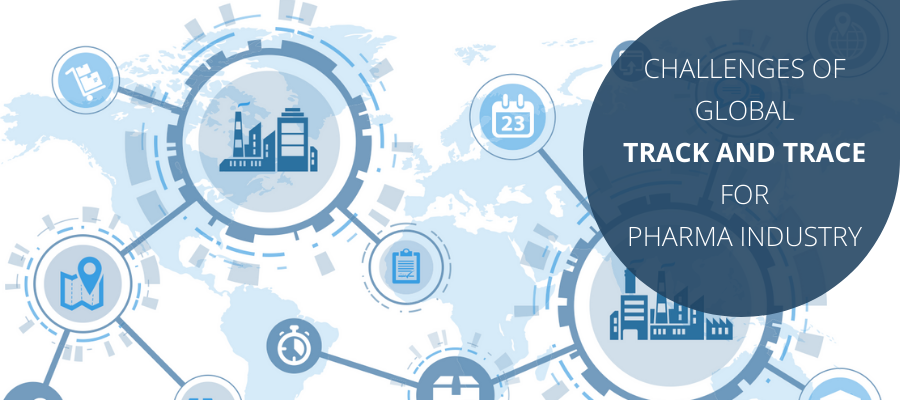
Table of Contents
Several crucial challenges of track and trace project implementation in 2021
The track and trace solutions market is projected to reach USD 4.21 billion by 2024 from USD 2.16 billion in 2019, at a CAGR of 14.2%. Factors such as the stringent regulations & standards for the implementation of serialization, increasing focus of manufacturers on brand protection, growth in the number of packaging-related product recalls, high growth in the generic and OTC markets, and growth in the medical device industry are considered as a key driver of the track and trace solutions market.*
Non-compliance with Track and Trace regulations leads to restrictions on market entry, which can cause a business loss, and any false instances such as damaged printing or even missing one, incorrect data, etc. would lead to penalties and product recalls. This challenge is becoming highly complex and critical for the pharma industry.
According to specific market researches, the industry has realized the extent of several crucial challenges of track and trace project implementation.
DIVERSE REGULATIONS
It can be a tough thing to modify your production as you work in many different markets since the pharma serialization is a topic in many legislations as the USA DSCSA, EU FMD, India, China, Brazil, Turkey, Argentina, Saudi Arabia, Korea, and other. The biggest challenge for manufacturers is to have one common solution that can meet their present needs and have the scalability to meet future requirements.
Learn how SoftGroup can help you to switch to another Regulatory compliance easily >>
ARTWORK MODIFICATION
Before the implementation of serialization in pharmaceutical manufacturing had become a hot topic, the printing was limited to batch numbers and expiry dates. But now, 2D code data matrix and GTIN, batch numbers, expiry dates, and unique serial numbers are required fields. If the sufficient space is not enough the packaging must be modified or the printing space must be changed to a different plane of packaging. Aggregation also has an impact on artwork modification. This additional information imposes a rethinking of the design of secondary packaging.
INTEGRATION WITH EXISTING PACKAGING-LINE EQUIPMENT
Pharma manufacturing companies have been using a wide variety of equipment — many brands, starting from top-end packaging machinery from World-class brands as Romaco, PAGO, and others to low-cost machinery from China and India. Integrating serialization systems with existing equipment (especially with a cartoner machine, labeler, and case packer) and using existing printers (of course, it must be serialization-compatible) is very challenging.
SPACE CONSTRAINTS ON PRODUCTION FLOOR
Almost all the small and medium-sized pharmaceutical manufacturer’s plants have space constraints for additional serialization or aggregation equipment. The biggest challenge is to select the best possible equipment and process while minimizing minimum line extensions. The latest trend is to build an integrated system that includes serialization (printing and inspection) and tamper evidence (if TE applicable for the target markets) in the same machine, and integration of aggregation software in the case packer.
Discover how SoftGroup has met the small-space challenge for its customer >>
MULTIPLE PACKAGING CONFIGURATIONS ON THE SAME LINE
SMEs in the Pharmaceutical industry as manufacturers and Contract Manufacturing Organizations (CMOs) are struggling to find the most appropriate technology that will ensure the utilization of packaging lines for the largest variety of packaging configurations. The main obstacle to be eliminated is the frequent machine settings changeover. With the introduction of serialization and aggregation equipment, the line start-up time had also increased. With multiple sizes of packaging running on the same line, it further increases the complexity and affects the overall efficiency of the production line.
Find how SoftGroup manages to deliver its customers with the widest size range option on the market for different single carton package with no hand setting of the format parts >>
IT ARCHITECTURE AND INFRASTRUCTURE
The implementation of the serialization solution has arisen many additional questions within the pharma manufacturers, CMOs, and other participants in the supply chain.
Is it to go for an on-site solution or cloud-based solution? How can track and trace processes be integrated with enterprise-level serialization servers and, most importantly, will the infrastructure be able to handle the storage of billions of events, secure data exchange (from server to line and back, as well as with trading partners and governments), operate with minimum downtime, ensuring 0 % data loss?
One of the main challenges that SMEs in the pharmaceutical industry facing is to find what fits their business model mostly. The Cloud-based software (SaaS) for serialization data management on-site level is considered as an alternative to the software with an on-premise installation that has the tag name “Traditional model”.
Lately, many small and medium-sized pharmaceutical companies with which we are talking about daily are considering SaaS as their first choice for Level 3 serialization software. Of course, the main challenges are the role of the IT team, the size of the starting investment, scalability and integration, the availability of new software updates, and the implementation time frame.
Read the article “Serialization software: On-premise or Cloud-based? What to choose?” >>
AGGREGATION
Pharmaceutical aggregation greatly facilitates the use of rework. It is possible because all necessary and at the same time important information about the medicines to be accessible when scanning the greater pack code. This will save a great deal of time since it is no longer needed to open each container to scan each individual package. But there is a big challenge of keeping the line efficiency. The selection of the right aggregation method is crucial and depends on the current line equipment, existing packaging process, and configuration.
Due to the industry researches, the improper selection of the aggregation methodology results in a production loss of almost 30%.
MULTIPLE LINE-LEVEL SOLUTION PROVIDERS AND VENDOR-LOCKING ARCHITECTURE
Some pharmaceutical companies have been working with more than one vendor to ensure they are compliant with the track and trace within a single plant or in different plants. This can also ensure lower downtime or even zero % of downtime due to maintenance of the system or problems with the serialization software.
It can be a significant challenge for some of the industry players since the IT enterprise track and trace solution provider integration can be easily made by only a few track and trace solutions providers. If the existing supplier’s architecture is vendor-locking (cannot accommodate any other IT vendor or line vendor, etc.), this would be a significant issue.
Go to the complete checklist for choosing a future-proof track and trace solution. Find what to consider when evaluating a track and trace provider in totality >>
REGULATORY COMPLIANCE AND DATA INTEGRITY
Over the last years, the data integrity topic has received more and more attention. The American Food and Drug Administration (FDA) issued guidance on data integrity related to current Good Manufacturing Practice (cGMP) compliance. Other regulatory agencies – such as European Medicines Agency (EMA) and Medicines and Healthcare products Regulatory Agency UK (MHRA) – are focusing on data integrity as well. Although these guidelines are ‘non-binding recommendations’, data integrity is usually a ‘hot topic’ during audits and inspections in the pharmaceutical industry.
Serialization and aggregation are an integral part of the secondary and tertiary packaging. The impact from duplicate serial numbers printed and accepted, can be serious for the pharma business operation as rejection, rework or maybe even product recalls. This would cost you a lot of money for the pharma manufacturers.
TIME
After the implementation of many regulations as the Russian Track and Trace Compliance, the level of challenges have escalated considerably with the enormous pressure of timelines and last-minute changes when it comes to implementation. Typically, full implementation takes at least six months (project start-up, documentation, manufacturing, FAT, SAT, and validation), and due to the high volume of business and prioritization of customers according to the expected joint business volume, the delivery timeline can be more than the abovementioned period.
Achieving the Russian Track and Trace Compliance in 6 weeks is a possible mission. Learn how >>
*Source: https://www.prnewswire.com/news-releases/the-4-21bn-track–trace-solutions-market-worldwide-opportunity-outlook-2019-to-2024–300848019.html


